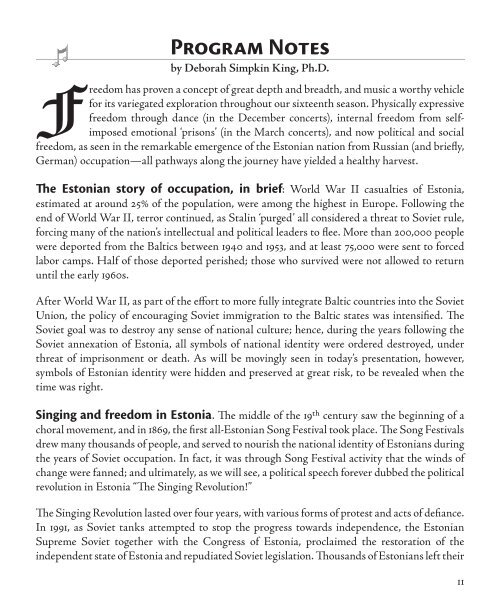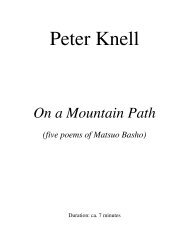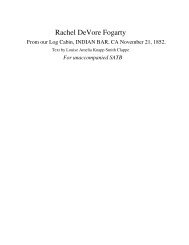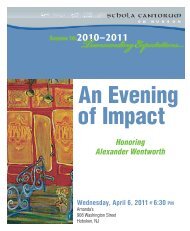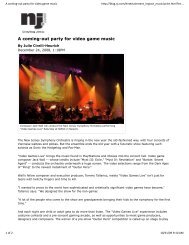Music of Estonia - Schola Cantorum on Hudson
Music of Estonia - Schola Cantorum on Hudson
Music of Estonia - Schola Cantorum on Hudson
Create successful ePaper yourself
Turn your PDF publications into a flip-book with our unique Google optimized e-Paper software.
Program Notes<br />
by Deborah Simpkin King, Ph.D.<br />
Freedom has proven a c<strong>on</strong>cept <str<strong>on</strong>g>of</str<strong>on</strong>g> great depth and breadth, and music a worthy vehicle<br />
for its variegated explorati<strong>on</strong> throughout our sixteenth seas<strong>on</strong>. Physically expressive<br />
freedom through dance (in the December c<strong>on</strong>certs), internal freedom from selfimposed<br />
emoti<strong>on</strong>al ‘pris<strong>on</strong>s’ (in the March c<strong>on</strong>certs), and now political and social<br />
freedom, as seen in the remarkable emergence <str<strong>on</strong>g>of</str<strong>on</strong>g> the <str<strong>on</strong>g>Est<strong>on</strong>ia</str<strong>on</strong>g>n nati<strong>on</strong> from Russian (and briefly,<br />
German) occupati<strong>on</strong>—all pathways al<strong>on</strong>g the journey have yielded a healthy harvest.<br />
The <str<strong>on</strong>g>Est<strong>on</strong>ia</str<strong>on</strong>g>n story <str<strong>on</strong>g>of</str<strong>on</strong>g> occupati<strong>on</strong>, in brief: World War II casualties <str<strong>on</strong>g>of</str<strong>on</strong>g> <str<strong>on</strong>g>Est<strong>on</strong>ia</str<strong>on</strong>g>,<br />
estimated at around 25% <str<strong>on</strong>g>of</str<strong>on</strong>g> the populati<strong>on</strong>, were am<strong>on</strong>g the highest in Europe. Following the<br />
end <str<strong>on</strong>g>of</str<strong>on</strong>g> World War II, terror c<strong>on</strong>tinued, as Stalin ‘purged’ all c<strong>on</strong>sidered a threat to Soviet rule,<br />
forcing many <str<strong>on</strong>g>of</str<strong>on</strong>g> the nati<strong>on</strong>’s intellectual and political leaders to flee. More than 200,000 people<br />
were deported from the Baltics between 1940 and 1953, and at least 75,000 were sent to forced<br />
labor camps. Half <str<strong>on</strong>g>of</str<strong>on</strong>g> those deported perished; those who survived were not allowed to return<br />
until the early 1960s.<br />
After World War II, as part <str<strong>on</strong>g>of</str<strong>on</strong>g> the effort to more fully integrate Baltic countries into the Soviet<br />
Uni<strong>on</strong>, the policy <str<strong>on</strong>g>of</str<strong>on</strong>g> encouraging Soviet immigrati<strong>on</strong> to the Baltic states was intensified. The<br />
Soviet goal was to destroy any sense <str<strong>on</strong>g>of</str<strong>on</strong>g> nati<strong>on</strong>al culture; hence, during the years following the<br />
Soviet annexati<strong>on</strong> <str<strong>on</strong>g>of</str<strong>on</strong>g> <str<strong>on</strong>g>Est<strong>on</strong>ia</str<strong>on</strong>g>, all symbols <str<strong>on</strong>g>of</str<strong>on</strong>g> nati<strong>on</strong>al identity were ordered destroyed, under<br />
threat <str<strong>on</strong>g>of</str<strong>on</strong>g> impris<strong>on</strong>ment or death. As will be movingly seen in today’s presentati<strong>on</strong>, however,<br />
symbols <str<strong>on</strong>g>of</str<strong>on</strong>g> <str<strong>on</strong>g>Est<strong>on</strong>ia</str<strong>on</strong>g>n identity were hidden and preserved at great risk, to be revealed when the<br />
time was right.<br />
Singing and freedom in <str<strong>on</strong>g>Est<strong>on</strong>ia</str<strong>on</strong>g>. The middle <str<strong>on</strong>g>of</str<strong>on</strong>g> the 19th century saw the beginning <str<strong>on</strong>g>of</str<strong>on</strong>g> a<br />
choral movement, and in 1869, the first all-<str<strong>on</strong>g>Est<strong>on</strong>ia</str<strong>on</strong>g>n S<strong>on</strong>g Festival took place. The S<strong>on</strong>g Festivals<br />
drew many thousands <str<strong>on</strong>g>of</str<strong>on</strong>g> people, and served to nourish the nati<strong>on</strong>al identity <str<strong>on</strong>g>of</str<strong>on</strong>g> <str<strong>on</strong>g>Est<strong>on</strong>ia</str<strong>on</strong>g>ns during<br />
the years <str<strong>on</strong>g>of</str<strong>on</strong>g> Soviet occupati<strong>on</strong>. In fact, it was through S<strong>on</strong>g Festival activity that the winds <str<strong>on</strong>g>of</str<strong>on</strong>g><br />
change were fanned; and ultimately, as we will see, a political speech forever dubbed the political<br />
revoluti<strong>on</strong> in <str<strong>on</strong>g>Est<strong>on</strong>ia</str<strong>on</strong>g> “The Singing Revoluti<strong>on</strong>!”<br />
The Singing Revoluti<strong>on</strong> lasted over four years, with various forms <str<strong>on</strong>g>of</str<strong>on</strong>g> protest and acts <str<strong>on</strong>g>of</str<strong>on</strong>g> defiance.<br />
In 1991, as Soviet tanks attempted to stop the progress towards independence, the <str<strong>on</strong>g>Est<strong>on</strong>ia</str<strong>on</strong>g>n<br />
Supreme Soviet together with the C<strong>on</strong>gress <str<strong>on</strong>g>of</str<strong>on</strong>g> <str<strong>on</strong>g>Est<strong>on</strong>ia</str<strong>on</strong>g>, proclaimed the restorati<strong>on</strong> <str<strong>on</strong>g>of</str<strong>on</strong>g> the<br />
independent state <str<strong>on</strong>g>of</str<strong>on</strong>g> <str<strong>on</strong>g>Est<strong>on</strong>ia</str<strong>on</strong>g> and repudiated Soviet legislati<strong>on</strong>. Thousands <str<strong>on</strong>g>of</str<strong>on</strong>g> <str<strong>on</strong>g>Est<strong>on</strong>ia</str<strong>on</strong>g>ns left their<br />
11


